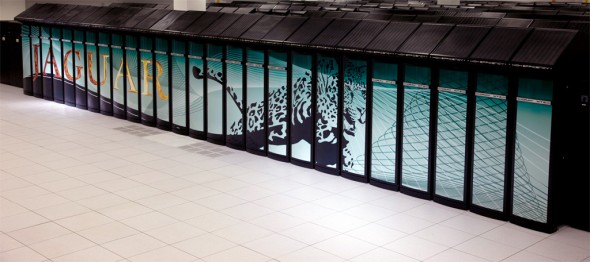Jaguar Gone But Not Forgotten
 ORNL’s Jaguar, the supercomputer that brought working scientific applications into the petascale, has left the theater.
ORNL’s Jaguar, the supercomputer that brought working scientific applications into the petascale, has left the theater.
Once the world’s most powerful system, Jaguar has morphed into Titan, a behemoth that is capable of churning through 20 thousand trillion calculations each second—20 petaflops—or more.
Titan is a unique accomplishment. It is already hosting groundbreaking research, and it will lead the way toward the next milestone, exascale systems capable of a million trillion calculations a second. But before we go too far down that road, it is fitting that we acknowledge the accomplishments of its predecessor.
Jaguar first came on line in 2005, sporting 56 cabinets, 5,212 single-core processors, and a peak performance of 25 trillion calculations per second, or 25 teraflops. That November the Top500 list said it was the 10th most powerful supercomputer in the world.
The Top500 list—and the supercomputing world in general—are intensely competitive, and the top of the list is notoriously volatile. Nevertheless, Jaguar stayed at or near the top throughout its existence. It was the most powerful supercomputer in the world between November 2009 and November 2010, and it stayed in the top 10 from November 2006 until its transformation into Titan this autumn.
It did so through a series of upgrades, half a dozen to be precise, that increased its speed 92 times over. At the time Jaguar’s transition to Titan began, the system had 200 cabinets holding 224,256 processing cores and boasted a peak performance of 2.3 petaflops. In its last appearance on the Top500 list this past June, it came in as the world’s sixth most powerful system.
“Jaguar was always a remarkably capable machine for science, throughout all its upgrades,” said ORNL astrophysicist Bronson Messer. “It remained a remarkably stable and productive resource even when it received state-of-the-art interconnects and the latest processor memory technologies.”
Speed in a scientific supercomputer is not a virtue in itself. What raw power does is to give application developers the opportunity to simulate physical systems with increased complexity and accuracy. It provides more and better information in a shorter time.
The real measure of a scientific supercomputer, then, is in the performance of real scientific applications, and in this measure Jaguar excelled. In 2008, a team led by Thomas Schulthess, now director of the Swiss national supercomputing center, used Jaguar to run a simulation of superconductors, or materials that conduct electricity without resistance. The application, known as DCA++, reached 1.352 petaflops, making it the first scientific application to break the petaflop barrier.
It was the first, but it was not the last. ORNL’s Markus Eisenbach led the effort to do the same for WS-LSMS, an application that analyzes magnetic systems and, in particular, the effect of temperature on these systems. The application reached 1.04 petaflops on Jaguar shortly after the DCA++ achievement.
Two other applications reached the petascale on Jaguar. Edoardo Aprà of ORNL and colleagues got there with NWChem, a quantum chemistry application that accurately describes the electronic structure of water. And Gerhard Klimeck of Purdue University and colleagues joined the club with OMEN, an application that delves into the quantum mechanical behavior of electrons traveling through electronic devices at the smallest possible scale.
Jaguar’s accomplishments had other acknowledgements as well. Each year the Association for Computing Machinery and the Institute of Electrical and Electronics Engineers recognize the world’s leading application with the Gordon Bell Prize.
Applications using Jaguar dominated the awards for several years. Schulthess’s team took the award in 2008, while Eisenbach’s picked it up in 2009. The 2010 winner, a team from Georgia Tech, New York University, and ORNL, reached 700 teraflops with a groundbreaking simulation of blood flow. And Klimeck’s team was a finalist in 2011.
Yet, while high-profile awards may hint at a system’s value, the true legacy of Jaguar is in the hundreds of research projects that were able to advance our knowledge across the gamut of computational science.
“The list of awards and high-placements on the top 500 list are important metrics to measure the success of Jaguar,” Messer acknowledged, “but its real legacy is in the sheer volume and quality of science produced with the machine.”





